|
|
|
Sort Order |
|
|
|
Items / Page
|
|
|
|
|
|
|
| Srl | Item |
| 1 |
ID:
112720


|
|
|
|
|
| Publication |
2012.
|
| Summary/Abstract |
We investigate bank risk taking, efficiency and their relation to law enforcement using a unique sample of 133 Chinese city commercial banks across 31 regions for the 1999-2008 period. We find that stronger law enforcement tends to promote greater bank risk taking in the region. Furthermore, employing a stochastic distance function approach, our analysis shows that the performance of Chinese city commercial banks, as measured by bank efficiency, is heavily influenced by the effectiveness of law enforcement in the region. Better legal environment, higher efficiency in the legal system, and stronger protection of intellectual property right are associated with a higher level of efficiency among these banks.
|
|
|
|
|
|
|
|
|
|
|
|
|
|
|
|
| 2 |
ID:
112723
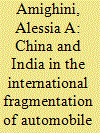

|
|
|
|
|
| Publication |
2012.
|
| Summary/Abstract |
We explore the relative positions of China and India in the international fragmentation of automobile production by analyzing disaggregated trade flows, while distinguishing between final and intermediate goods. The size and composition of trade has significantly moved in favor of trade of components over the last decade, but major differences exist between the two countries; China is a net car importer, while India is a net car exporter. We find evidence of the increasing importance of two-way trade in vertically differentiated goods, indicating that China and India are becoming more active participants in the vertical division of labor in automotive production.
|
|
|
|
|
|
|
|
|
|
|
|
|
|
|
|
| 3 |
ID:
112716


|
|
|
|
|
| Publication |
2012.
|
| Summary/Abstract |
This paper estimates peer effects on student achievement using a panel data set from a middle school in China. Unique features of the organization of Chinese middle schools (Grades 7 to 9) and panel data allow us to overcome difficulties that have hindered the separation of peer effects from omitted individual factors due to self-selection and from common teacher effects and to identify peer effects at the classroom level. We estimate peer effects for Math, English, and Chinese test scores separately. In a linear-in-means model controlling for both individual and teacher-by-test fixed effects, peers are found to have a positive and significant effect on math test scores, a positive but insignificant effect on Chinese test scores, but no effect on English test scores. Importantly, in Math and Chinese students at the middle of the ability distribution tend to benefit from better peers, whereas students at the ends of the ability distribution do not, suggesting that policy makers who want to exploit positive peer effects face difficult tradeoffs in classroom and school assignment.
|
|
|
|
|
|
|
|
|
|
|
|
|
|
|
|
| 4 |
ID:
112729


|
|
|
|
|
| Publication |
2012.
|
| Summary/Abstract |
Corruption is one of the most pervasive obstacles to economic and social development. However, in the existing literature it appears that corruption seems to be less harmful in some countries than in others. The most striking examples are well known as the "East Asian paradox": countries displaying exceptional growth records despite having thriving corruption cultures. The aim of this paper is to explain the high corruption but fast economic growth puzzle in China by providing firm-level evidence of the relation between corruption and growth and investigating how financial development influences the former relationship. Our empirical results show that corruption is likely to contribute to firms' growth. We further highlight the substitution relationship between corruption and financial development on firm growth. This means that corruption appears not to be a vital constraint on firm growth if financial markets are underdeveloped. However, pervasive corruption deters firm growth where there are more developed financial markets. This implies that fast firm growth will not be observed until a later stage of China's development when financial markets are well-functioning and corruption is under control. Furthermore, the substitution relationship exists in the private and state-owned firms. Geographically, similar results can be seen in the Southeast and Central regions.
|
|
|
|
|
|
|
|
|
|
|
|
|
|
|
|
| 5 |
ID:
112732
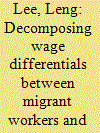

|
|
|
|
|
| Publication |
2012.
|
| Summary/Abstract |
This paper looks at wage discrimination faced by China's rural-urban migrants. Using data from the China Urban Labour Survey, it uses standard wage decomposition techniques to measure the extent wage gaps between migrants and locals are attributable to migration. Because the survey covers five cities, the results allow for an investigation regarding how much variation in discrimination there is. Unlike previous studies of wage discrimination in China, this research includes a more full measure of remuneration by including non-financial benefits as well as bonuses earned. The results suggest that migrants still face a significant amount of discrimination, but that this varies a lot between cities.
|
|
|
|
|
|
|
|
|
|
|
|
|
|
|
|
| 6 |
ID:
112721
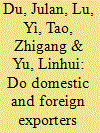

|
|
|
|
|
| Publication |
2012.
|
| Summary/Abstract |
In view of the importance of intra-firm trade and export-platform FDI conducted by multinationals, we investigate how domestic firms and foreign affiliates exhibited differential impacts of export entry and exit on productivity changes. Using a comprehensive dataset from China's manufacturing industries, we employ the Olley-Pakes method to estimate firm-level TFP and the matching techniques to isolate the impacts of export participation on firm productivity. Robust evidence is obtained that domestic firms displayed significant productivity gains (losses) upon export entry (exit), whereas foreign affiliates showed no evident TFP changes. Moreover, the productivity gains for domestic export starters were more pronounced in high- and medium-technology industries than in low-technology ones. We explain our findings from the perspective of the technology gap theory after considering processing trade and the fragmentation of production stages in the era of globalization.
|
|
|
|
|
|
|
|
|
|
|
|
|
|
|
|
| 7 |
ID:
112726
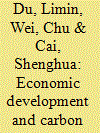

|
|
|
|
|
| Publication |
2012.
|
| Summary/Abstract |
This paper investigates the driving forces, emission trends and reduction potential of China's carbon dioxide (CO2) emissions based on a provincial panel data set covering the years 1995 to 2009. A series of static and dynamic panel data models are estimated, and then an optimal forecasting model selected by out-of-sample criteria is used to forecast the emission trend and reduction potential up to 2020. The estimation results show that economic development, technology progress and industry structure are the most important factors affecting China's CO2 emissions, while the impacts of energy consumption structure, trade openness and urbanization level are negligible. The inverted U-shaped relationship between per capita CO2 emissions and economic development level is not strongly supported by the estimation results. The impact of capital adjustment speed is significant. Scenario simulations further show that per capita and aggregate CO2 emissions of China will increase continuously up to 2020 under any of the three scenarios developed in this study, but the reduction potential is large.
|
|
|
|
|
|
|
|
|
|
|
|
|
|
|
|
| 8 |
ID:
112731


|
|
|
|
|
| Publication |
2012.
|
| Summary/Abstract |
In many countries inward foreign direct investment (FDI) typically concentrates in a few regions. However, there is little empirical evidence on whether spatially concentrated FDI boosts economic growth in other regions within the same country. We use a dataset that covers 96% of Chinese cities from 1996 to 2004 and find that "inter-regional spillovers" from FDI concentrated in China's coastal cities have a positive and significant effect on the growth of inland cities. In addition, an inland city's industrial development affects its absorptive capacity to gain such inter-regional spillovers from coastal FDI.
|
|
|
|
|
|
|
|
|
|
|
|
|
|
|
|
| 9 |
ID:
112717


|
|
|
|
|
| Publication |
2012.
|
| Summary/Abstract |
China has recently undergone a series of reforms on higher education aimed at raising the level of human capital. However, relatively little is known about returns to higher education (i.e. college premium) and how it varies across population in China over time. In this paper, we contribute to the literature by examining college premium in urban China during the period of 1995-2002. We also explore the differences in college premium by gender and by sector. To isolate the causal effects of college education, we employ a novel instrumental variable approach based on heteroskedasticity in college decision to circumvent potential endogeneity and measurement error problems. Our results imply a much larger college premium and a greater growth in the college premium relative to their OLS counterparts, consistent with the general literature on returns to education. More interestingly and starkly contrasting to the existing studies using OLS in the Chinese context, our results imply that (1) the college premium is larger for women than for men in the early stage of economic reforms, but the difference decreases and becomes statistically insignificant over time; (2) the college premium is larger for workers in the state-owned enterprises than that in the non-state-owned enterprises during the early stage of economic reforms; this gap is, however, reversed in the later stage. We discuss potential reasons for these results.
|
|
|
|
|
|
|
|
|
|
|
|
|
|
|
|
| 10 |
ID:
112728


|
|
|
|
|
| Publication |
2012.
|
| Summary/Abstract |
This paper presents a meta-analysis of 5308 observations of total factor productivity growth (TFPG) in China from 150 primary studies to provide some insightful explanations to the controversies about productivity growth in China in the current literature. The main findings include that (1) the mean TFPG of the aggregate economy at the national level in the current literature is only about 2% after 1978, which barely contributes to 20% economic growth; (2) there are three cycles for TFPG after 1978 and each circle lasts about 10 years; (3) sector-specific TFPGs are generally larger than aggregate economic TFPGs; (4) regional disparities of TFPG are significant and specifically the TFPG in East China is higher than that in Central and West China; (5) TFPG after 1978 is in general greater than that before 1978; and (6) peer-review process and paper languages are significantly correlated with TFPG results.
|
|
|
|
|
|
|
|
|
|
|
|
|
|
|
|
| 11 |
ID:
112730


|
|
|
|
|
| Publication |
2012.
|
| Summary/Abstract |
We estimate the disaggregate import demand functions for three basic classes of goods as defined in the System of National Accounts (SNA): capital goods, intermediate inputs, and final consumption goods, and use the findings to shed light on the effects of China's economic growth on its current account. The results showed that as China switches from exports to domestic demand as a key driver for economic growth, China's trade surplus would be expected to shrink rather quickly.
|
|
|
|
|
|
|
|
|
|
|
|
|
|
|
|
| 12 |
ID:
112734
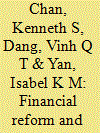

|
|
|
|
|
| Publication |
2012.
|
| Summary/Abstract |
This paper examines the impact of recent financial reforms in China on the financing constraints and investment of publicly-listed Chinese firms. Two continuous indices are constructed to measure the evolution and intensity of financial reforms: a financial liberalization index and a capital control index. Dynamic panel GMM method is used to estimate firms' financing constraints in an Euler-equation investment model. Based on panel data of listed firms for 1996-2007, we find that large firms face no credit constraints and smaller firms display significant constraints. However, the sensitivity of large firms' investment to their cash holdings is heightened as more financial reforms take place. It appears that reforms that gradually eliminate preferential treatments to large firms, primarily state-owned enterprises (SOEs) in China, have subjected these firms' investment decisions to stricter market-based discipline and therefore raised their financing constraints. No significant change in the financing constraint is detected for smaller firms in China. This is interpreted as financial reform in China has not been substantial enough for its benefits to reach smaller firms.
|
|
|
|
|
|
|
|
|
|
|
|
|
|
|
|
| 13 |
ID:
112727
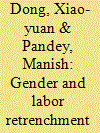

|
|
|
|
|
| Publication |
2012.
|
| Summary/Abstract |
In the late 1990s, China's state-owned enterprises (SOEs) underwent dramatic labor retrenchment, drawing considerable attention to how women fared relative to men during the retrenchment process. However, almost all the existing studies on the subject rely on individual-level data. In this paper, we study the gender patterns of SOE labor retrenchment using a unique enterprise-level dataset for the period from 1995 to 2001. We find that disproportionately large share of discharge was borne by female workers and that female discharge rates were more sensitive to output growth than male discharge rates. Further, estimating dynamic labor demand equations by gender, we find that female employment was more sensitive to negative output shocks experienced by enterprises than male employment but less sensitive to positive output shocks. Further, we find that sensitivity of female employment to output was greater for reformed than non-reformed enterprises and for male-intensive than female-intensive sectors. These results provide new insights into the gender patterns of employment adjustment of Chinese SOEs to output shocks during the retrenchment period.
|
|
|
|
|
|
|
|
|
|
|
|
|
|
|
|
| 14 |
ID:
112719


|
|
|
|
|
| Publication |
2012.
|
| Summary/Abstract |
China's over 25% aggregate household saving rate is one of the highest in the world. One popular view attributes the high saving rate to fast-rising housing prices in China. However, cross-sectional data do not show a significant relationship between housing prices and household saving rates. This article uses a simple consumption-saving model to explain why rising housing prices per se cannot explain China's high household saving rate. Although borrowing constraints and demographic changes can translate housing prices to the aggregate saving rate, quantitative simulations of our model using Chinese time-series data on household income, housing prices, and demographics indicate that rising mortgage costs can increase the aggregate saving rate by at most 2 to 4 percentage points in the best down-payment structure.
|
|
|
|
|
|
|
|
|
|
|
|
|
|
|
|
| 15 |
ID:
112724


|
|
|
|
|
| Publication |
2012.
|
| Summary/Abstract |
Recently, Foreign Invested Enterprises (FIEs) in China have increased their investment in not only production activity but also R&D activity. This paper examines the impact of spillovers from such activities by FIEs on two types of innovations by Chinese domestic firms: Total Factor Productivity (TFP) and invention patent application, using comprehensive industry and province-level data. We evaluate such spillovers according to FIEs' ownership structure, the origin of foreign funds and whether they are from the same industry or from other industries. We find an interesting asymmetry between spillovers to TFP and invention patent applications; while we do not find significant intra-industry spillovers from FIEs but find robust inter-industries spillover related to TFP, we find substantial intra-industry spillovers promoting invention patent applications but no evidence of inter-industries spillovers. Furthermore, whereas spillovers from FIEs to Chinese firms' TFP stem from their production activities, the source of spillovers related to invention patent applications is mostly through their R&D activity. Our findings indicate a need for multidimensional evaluation of the role of FDI in developing countries.
|
|
|
|
|
|
|
|
|
|
|
|
|
|
|
|
| 16 |
ID:
112718


|
|
|
|
|
| Publication |
2012.
|
| Summary/Abstract |
There have been growing concerns about the effects of food safety standards on agricultural trade throughout the world. The objective of this paper is to assess the impacts of food safety standards on tea exports from China, the world's largest tea producer and exporter. To achieve this objective, the paper discusses the trends and nature of China's tea production and export, analyzes changes on tea safety standards indicated by Sanitary and Phytosanitary (SPS) measures, Maximum Residual Limit (MRL) of pesticides and the coverage of tea safety standards concerning regulatory pesticides in major importing countries, and quantitatively estimates the impacts of food safety standards on China's tea export based on a gravity model. The results show that the MRL of pesticides (e.g., endosulfan, fenvalerate and flucythrinate) imposed by importing countries have significantly affected China's tea exports. The results also show that China's tea exports have been significantly restricted when importing countries increase coverage of tea safety standards concerning regulatory pesticides.
|
|
|
|
|
|
|
|
|
|
|
|
|
|
|
|
| 17 |
ID:
112733


|
|
|
|
|
| Publication |
2012.
|
| Summary/Abstract |
We employ a new classification of ownership identity to analyze the impact of ownership structure on enterprise performance in China. Using both fixed effects model and Generalized Methods of Moments (GMM), this study finds that marketized state-owned enterprises outperform firms controlled by the government, indicating that partial privatization of state-owned Chinese firms improves corporate governance. Non-controlling large shareholders of marketized state-owned enterprises and private enterprises are found to play active roles in corporate governance. Lastly, there is evidence that ownership concentration of a controlling shareholder decreases the incentives to expropriate minority shareholders.
|
|
|
|
|
|
|
|
|
|
|
|
|
|
|
|
| 18 |
ID:
112722


|
|
|
|
|
| Publication |
2012.
|
| Summary/Abstract |
This paper presents numerical simulation results that suggest that China can both reduce its trade imbalance and receive welfare benefits by switching the value added tax (VAT) regime from the current destination principle to an origin principle. We modify the traditional general equilibrium tax model to capture endogenous trade imbalances along with endogenous factor supply, a fixed exchange rate and a non-accommodative monetary policy structure which supports the Chinese trade imbalance. We calibrate model parameters to 2008 data and simulate counterfactual equilibrium for VAT tax basis switches in which the trade imbalance changes. Our results suggest that given China's trade surplus VAT regime switching to an origin basis can decrease China's trade surplus by over 40%, and additionally increase Chinese and world welfare. This has implications for present G20 discussions on finding ways to adjust global trade imbalances.
|
|
|
|
|
|
|
|
|
|
|
|
|
|
|
|
| 19 |
ID:
112715


|
|
|
|
|
| Publication |
2012.
|
| Summary/Abstract |
We use three waves of urban household survey from 1995 to 2007 to investigate the trends of residual inequality and its determinants. First, we find that the enlargement in both the overall and residual inequality was larger at the upper half of the wage distributions between 2002 and 2007. Between 1995 and 2002, however, it is the lower half that experienced larger increase in inequality. Second, by using two complementary semi-parametric methods, we find that composition effect is negligible. Instead, the change in skill prices plays a dominant role in the rise of residual inequality. Finally, by constructing a panel data at the city level, we find that ownership restructuring is an important factor that has caused the skill price to rise, especially in the earlier period. Another finding is that China's export share of GDP has a positive effect on the enlargement of residual wage inequality, especially in the period from 2002 to 2007.
|
|
|
|
|
|
|
|
|
|
|
|
|
|
|
|
| 20 |
ID:
112725


|
|
|
|
|
| Publication |
2012.
|
| Summary/Abstract |
This paper improves renewal payment based patent value model by introducing unexpired patents into the model. We estimate value of the invention patents based on SIPO records in China and compare values of patents between local owners and owners from the U.S., Japan and European countries. The study reveals that patent value from Chinese owners is much lower than that of overseas owners. This larger value gap implies important difference in motive of the patenting and R&D quality between China and those technology intensive sources usually from economically advanced countries and regions. The model developed in this study is also applied to patent data in different technical fields, successfully differing technical sectors with higher value (e.g., machinery) and those with lower value (e.g., pharmaceuticals), in terms of China market based patent records. Both applications prove that the newly developed model can be an important analytical tool for providing classified patent value on different purposes, especially in case of China.
|
|
|
|
|
|
|
|
|
|
|
|
|
|
|
|
|
|
|
|
|